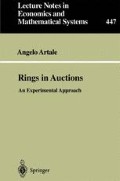Abstract
In this chapter we consider two interesting extensions. The case of the lattice mechanism with continuous bids is investigated in Section 5.1. In Section 5.2, we consider the case of a coalition of two players which bids non-cooperatively versus an individual bidder.
Access this chapter
Tax calculation will be finalised at checkout
Purchases are for personal use only
Preview
Unable to display preview. Download preview PDF.
Notes
Note that all we need to reduce the inefficiency of the lattice mechanism is to allow players to submit real bids. We assume that the types are continuous only because it makes the problem more tractable.
Although we prove our result under the assumption of independence, the result is true when we assume that each single variable is uniform distributed and the maximum of the n random variables has to be equal to or higher than r. In fact, if a player observes a value which is lower than r then it is optimal for him to bid zero, otherwise he is concerned only with the distribution of the maximum of the n-1 variables and this does not depend on his observation.
They consider both the case in which a coalition play versus another coalition, and the case in which a coalition play versus individual non collusive bidders. With three players, as in our set-up, the two cases coincide.
Marshall et al. make a more standard assumption that the values of each player are independently drawn by uniform distributions on the interval [0, 1].
To calculate this second probability correctly, it necessary that the coalition use a mechanism which is incentive compatible. Marshall et al. (1994) do not pose a collusive mechanism in the paper. They assume that the values of the members of a coalition are common knowledge within the coalition.
Author information
Authors and Affiliations
Rights and permissions
Copyright information
© 1997 Springer-Verlag Berlin Heidelberg
About this chapter
Cite this chapter
Artale, A. (1997). Two Extensions. In: Rings in Auctions. Lecture Notes in Economics and Mathematical Systems, vol 447. Springer, Berlin, Heidelberg. https://doi.org/10.1007/978-3-642-59158-7_5
Download citation
DOI: https://doi.org/10.1007/978-3-642-59158-7_5
Publisher Name: Springer, Berlin, Heidelberg
Print ISBN: 978-3-540-61930-7
Online ISBN: 978-3-642-59158-7
eBook Packages: Springer Book Archive

